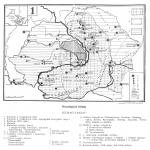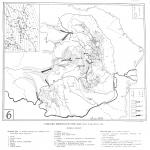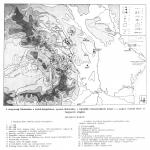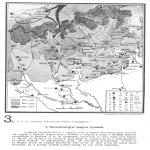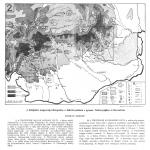CSÁNGÓ-WĘGIERSKI
Vilmos Tánczos: Hungarians in Moldavia (1998)
Original title: "Hányan vannak a moldvai csángók?"
Published in Magyar Kisebbség 1-2 (7-8), 1997 (III), pp. 370-390.
Translation by Miklós Zeidler
Linguistic editing by Rachel Orbell
Sponsored by the Illyés Foundation
Teleki László Foundation H-1125 Budapest, Szilágyi Erzsébet fasor 22/c
links (the same from more sites): here, here, here
parts from book:
The Term„Csángó”
Csángó is the official designation as well as the popular name for Hungarians living in Moldavia. Theetymology of the name of this ethnic group reveals an interesting detail in the history of the Csángós: according to a widespread, yet never fully verified hypothesis, the word Csángó derives from the verbcsang/csáng (i. e. to wander, stroll, ramble, rove etc.) and thus the name of this ethnic group clearlyrefers to the migratory, colonising character of the Csángós
The Moldavian Hungarians themselves donot constitute a homogeneous group, either historicallyor linguistic–ethnographically. The majority of researchers disagree with the use of the term Csángó asa general designation for them, preferring to differentiate between the earlier Moldavian Hungarianswho were settled there in the Middle Ages, and the fleeing Szeklers who arrived in the 17th–19thcenturies.
The Problem of Origins
References to Moldavian Hungarians appear in historical sources from the 13th century onwards. Sofar, however, there is no scientifically convincing explanation of their origins. One rather romanticview, according to which the Csángós are the successors of the Cumans (JERNEY 1851, MUNKÁCSI1902, VERESS 1934), has long been refuted, while a small minority believe that the MoldavianHungarians descend from a group of Hungarians who did not take part in the Conquest (RUBINYI1901, DOMOKOS 1931, GUNDA 1988). Currently, it is generally accepted that MoldavianHungarians arrived at their present settlements some time in the Middle Ages, and came from the Westrather than the East (AUNER 1908, LÜKŐ 1936, NĂSTASE 1934, MIKECS 1941, MIKECS 1943, BENDA 1989, BENKŐ 1990). Ideas differ, however, as to when, and with what objective, the firstsettlements were established, and from which parts of the Hungarian-populated lands the migrationtowards Moldavia began. Most researchers see a relationship between this group and the Hungarianpopulation of the Someş/Szamos Valley and the Upper Tisa/Tisza Region (LÜKŐ 1936, NĂSTASE1934, MIKECS 1941, MIKECS 1943, BENDA 1989). According to a theory based on linguisticgeography, the majority of the Csángós broke away from the Hungarian population of CâmpiaTransilvaniei/Mezőség in Inner Transylvania (BENKŐ 1990). It is possible that, in addition to thenon-Szekler Hungarianpopulation, there were also some Szeklers who settled in Moldavia as early asthe Middle Ages. Presumably, they populated mainly the southern parts, i. e. the lower regions of theSiret/Szeret and Trotuş/Tatros rivers (LÜKŐ 1936, MIKECS 1941). It is generally accepted that the original Csángós settled in Moldavia as part of a systematicHungarian imperial policy. Their task was to control and defend the eastern frontier of Hungary. Thisborder ran along the River Siret/Szeret, an indication that in medieval times, the eastward movementof the Hungarian ethnic collective did not stop at the Carpathians. The kings of Hungary wanted toexercise military control over the lands outside their borders and their watchtowers, outposts and border forts were pushed forward as far as the Dniester and Danube Rivers (Kilia, CetateaAlba/Dnyeszterfehérvár/ Akkerman, Brăila, Orhei/Őrhely etc.). The systematic settlement, which wasintended to safeguard the border region, could not havebeen carried out before the very end of the13th century. The earliest possible timing for the establishment of the first Moldavian border guardsettlements is after the 1241–1242 Mongol Invasion, and later in the early 14th century. In the courseof the 15th century, the number of Moldavian Hungarians increased due to the arrival of Hussiteheretics who had left Southern Hungary to escape from the Inquisition.There is no scientific backing for the Romanian view that Moldavian Csángós are Romanians whowere Magyarised by the Catholic Church. Today, this ideologically-based theory aims at the „re-Romanianisation” of the Csángós (MĂRTINAŞ 1985). Historical documents (see DOMOKOS 1987, BENDA 1989, HORVÁTH 1994), place names and proper names (ROSETTI 1905, VERESS 1934,LÜKŐ 1936, MIKECS 1943, BENKŐ 1990) and ethnographic evidence (KÓS–NAGY–SZENTIMREI 1981) attest to the fact that in certain areas of Moldavia– especially in the river valleysat the approach to the Carpathian passes, i. e. the most important locations from a military andstrategic point of view– the Hungarian presence preceded the Romanian influx.
History, Internal Classification, Historical Demography
Prior to the Mohács catastrophe in 1526, Moldavian Hungarians, an ethnic group vital to imperialpolicy, had enjoyed the security provided by a powerful, centralised Hungarian Kingdom. Historicaldocumentation proves that at the turn of the 16th century, the 20 to 25 thousand-strong Hungarianpopulation was the largest non-Romanian people within the ethnically mixed Moldavia (DOMOKOS1938, MIKECS 1941, BENDA 1989).
The Hungarian settlers occupied the wide and fertile river flats of the Siret/Szeret and, in particular, the territories around the deltas of its western tributaries (Moldova/Moldva, Bistriţa/Beszterce,Trotuş/Tatros). At this time, the territories populated by Hungarians were composed of enclosedsettlements, interconnected by unbroken lines of dwellings (e. g. between Suceava/Szucsava andRoman/Románvásár, around Bacău/Bákó, right of the Siret/Szeret river, in the Lower Trotuş/Tatrosregion etc.). Even towns were established in places of strategic economic, commercial and military importance, with majority Hungarian and partly German population (Roman = Román[vásár]i, Bacău= Bákó, Adjud = Egyed[halma], Trotuş = Tat[á]ros, Târgu Ocna = Aknavásár, Baia = [Moldva]bánya,Iaşi = Jász[vásár], Huşi = Husz, Bârlad = Barlád etc.). Urban life and trade developed in Moldavia inthe 15th and 16th centuries due to the activities of the Hungarians and Germans. (A very telling pieceof evidence is that the Romanian word „oraş”, i. e. town or city, is borrowed from the Hungarian „város”.) Urban development, however, washalted as early as the late 16th century because of theunfavourable politico–military situation, and was entirely destroyed as a result of the 17th-centuryTartar and Cossack military campaigns. The artisan and merchant population of the market towns, mostly ethnic Hungarians, were subsequently assimilated into the Romanian majority (MIKECS 1941p. 168–178., BENDA 1989 p. 35–37.). Ethnically and religiously homogeneous, and making their living mainly from cultivation, thepopulation of the Csángó villages in the flat lands were free tenants which meant that the communitiespaid corporate taxes directly to the Hungarian authorities in Transylvania, the Voivodes, without theintervention of the Moldavian nobility (boyars). Presumably, free Romanian villagesin Moldaviaadopted certain Csángó farming techniques and legal customs (e. g. certain forms of self-government,„arrow-lot” in the periodical distribution of village lands, the role of clan groups in land-ownership, etc.) (MIKECS 1941 p. 158–165.). In the Middle Ages, the inhabitants of the free villages in Moldaviawere called „razeşi”, which derives from the Hungarian „részes” (share-farmer). The settlementsystem marked by plot-groups and blind alleys, which illustrate clan relations, has survived in certainvillages (KÓS–NAGY–SZENTIMREI 1981 p. 17–22.). Certain Moldavian place names, as well as the existing documentation and the location of villageswhich were later Romanianised, clearly suggest that the territoryinhabited by the medieval MoldavianHungarian settlers was considerably larger than that which their successors occupy today. Over theyears, the Hungarian ethnic population disappeared from certain regions, both as a result of war, and
4of linguistic and religious assimilation. In other areas, villages were divided and the territoriesoccupied by Hungarians shrank. There are only two language enclaves where the descendants of themedieval non-Szekler Moldavian Hungarians have survived: the „northern Csángós” north of Romanand the„southern Csángós” in some villages south of Bacău. The central geographical location ofthese villages and their favourable economic conditions suggest that they were among the firstsettlements to be established in this province. Both northern and southern Csángós are characterised byarchaisms in their language (e.g. the sibilant pronunciation of the consonant„sz”– between„sh” and„s”–, the archaic pronunciation of the diphthong„lj”– today spelled„ly” etc.), as well as by theirfolklore which has retained many ancient elements.The largest and most central villages of the northern Csángós are Sabaoani/Szabófalva andPildeşti/Kelgyest. In a few of the Catholic villages around them (Iugani/Jugán, Traian/Újfalu, Bărgăoani/Bargován etc.) there are still some elderly people who speak Hungarian, while in othervillages, the Hungarians have been completely Romanianised. The heart of the northern enclave, Săbăoani/Szabófalva, was the mother community of Băluşeşti/Balusest and Ploscuţeni/Ploszkucény inthe lower Siret/Szeret region which were established later. The most important villages of the southern Csángós (living south of Bacau/Bákó) are ValeaSeacă/Bogdánfalva, Galbeni/Trunk, Valea Mare/Nagypatak, and Gioseni/Gyoszény, the last of whichshows strong Szekler influence. Valea Seacă/Bogdánfalva is the mother community of NicolaeBălcescu/Újfalu, founded after World War I. In Pădureni/Szeketura, only the older generation speaksHungarian. The number of Hungarians in Moldavia was reduced significantly in the 16th and 17th centuries bywars, epidemics and, importantly, by linguistic and religious assimilation to the Romanians. Numbersbegan to rise again only in the 18th century as a result of the increasing rate of emigration amongSzeklers. In particular, many eastern Szeklers moved to Moldavia after the Siculeni/MadéfalvaMassacre in 1764. Most of the existing „Szeklerised” Csángó villages date back to this time. Since there was little in the way of arable land in the economically backward Szekler regions, over-population in these areas meant that the flow of Szeklers into Moldavia continued intothe 19thcentury. Emigration was given new impetus at the turn of the century, although now it was the largertowns in the Romanian Kingdom (Regat) which were the targets of the Szeklers' trans-Carpathianexodus.A minority of the emigrants were Calvinists who were soon assimilated into the Catholic majority. Even in those villages where Calvinists formed the majority (e. g. Sascut/Szászkút, Pralea/Prálea, Vizantea/Vizánta), their original religion did not survive. It is clear that present-day Calvinists livingin the region do not descend from the Moldavian Csángós; the 518 Hungarian Calvinists recorded inMoldavia in the 1992 census are more recent immigrants. Moldavian settlements with Szeklerised Csángó inhabitants are markedly different from one another:a. When emigration was at its height (i. e. at the end of the 18th century), large homogeneousgroups set out towards the east and, once in Moldavia, generally stayed together. This is probably theperiod when regions which were sparsely populated, or uninhabited, witnessed the emergence of thebiggest ethnically and religiously homogeneous villages belonging to the Moldavian Szeklers(Pustiana/Pusztina, Frumoasa/Frumósza, Lespezi/Lészped, Pârgăreşti/Szőlőhegy and its vicinity,Arini/Magyarfalu, Vladnic/Lábnik, Călugăreni/Kalugarén etc.). Given that the best agricultural landwas already„taken”, the newcomers had to confine themselves to the narrow valleys of small riversand streams. Even relatively large Szekler villages in these areas thus have a kind of „mountain”atmosphere.b. There are several villages in which it seems that a previously existing Hungarian population, sometimes dating back to the Middle Ages, was later joined by Szeklers who had a significant effecton the language and culture of the village. This is clearly what happened in the villages ofGioseni/Gyoszény, Luizi-Călugăra/Lujzikalagor, Cleja/Klézse and Fărăoani/Forrófalva in the regionof the river Siret/Szeret, and possibly also in Fundu-Răcăciuni/Külsőrekecsin and Sascut-Sat/Szászkút(SZABÓ T. 1981 p. 518.). The Hungarian population of Grozeşti/Gorzafalva, Târgu Trotuş/Tatros andOneşti/Onyest along the Trotuş/Tatros and its tributaries may also have been established earlier. However, because the strong Szekler influence tended to submerge the original dialects, categorisationof such villages proved problematic for researchers using the methods of linguistic geography (LÜKŐ1936, SZABÓ T. 1981). It is interesting to note that the northern Csángós never mixed with theSzeklers, perhaps due to the higher population density in the northern Csángó territories and to the
5high number of villages.c. New settlements were founded in and around existing Romanian villages by Szeklers whoarrived in small, isolated groups, as well as by those who arrived later (in the 19th century) or thosewho moved away from the Moldavian villages. It is possible that certain villages had a mixed Szeklerand Romanian population. The small, ethnically mixed villages (Gârleni/Gerlény, Lilieci/Lilijecs,Tarâţa/Szoloncka, Floreşti/Szerbek, Verşeşti/Gyidráska, Enăcheşti/Jenekest, Turluianu/Turluján,Bogata/Bogáta, Dărmăneşti/Dormánfalva, Valea Câmpului/Szárazpatak etc.) situated in the valleys ofsmall rivers (Trotuş/Tatros, Tazlău/Tázló, Bistriţa/Beszterce and other minor rivers), and several of thevillages near the river Siret/Szeret (Chetriş/Ketris, Furnicari/Furnikár, Gheorghe Doja/Újfalu/Dózsaetc.) belong to this third multi-ethnic category of Szeklerised Csángó villages. Villages in theCarpathian highlands also witnessed a similar ethnic mixture (Ciugheş/Csügés,Brusturoasa/Bruszturósza, Gutinaş/Gutinázs, Ferestrău-Oituz/Fűrészfalva, VizanteaMănăstirească/Vizánta etc.). Small Hungarian villages can be found at the heads of mountain streamsor above the Romanian villages situated along the lower reaches of the streams (Cucuieţi/Kukujéc,Bogdăneşti/Ripa Jepi, Lărguţa/Lárguca, Neszujest (Strugari/Esztrugár), Valea Rea/Váliri (Livezi),Butucari/Butukár (Berzunţi/Berzunc), Seaca/Szálka, Cireşoaia/Szalánc, Cerdac/Cserdák,Capăta/Kápota, Pralea/Prálea etc.).Generally speaking, Szeklers who arrived in Moldavia in the 18th and 19th centuries occupiedrelatively large territories in the mainly mountainous, unpopulated regions which offered only alimited scope for cultivation and viticulture, as well as for animal husbandry or forestry. Thepopulation of Szekler villages was generally smaller than that of the medieval Moldavian Hungarianones. In many cases, this population was made up of sporadic groups within a multi-ethnic and multi-religious environment, another factor which helped to further their linguistic assimilation to theRomanians.
The huge increase in the Catholic population over the last two centuries cannot be considered toresult exclusively from the immigration of Catholic Szeklers to Moldavia. The number of Catholicsliving in Moldavia more than doubled between 1930 and 1992, and this 118% increase significantlyexceeds the similarly remarkable 67% growth in the population of Moldavia. However, it is importantto bear in mind that during „socialist industrialisation”, overpopulated Moldavia was the greatestsupplier of human resources in Romania, and in this period there were many Moldavian Csángós, aswell as Romanians, who moved to towns in Transylvania and to the southern industrial regions of thecountry. An estimated 50,000 people moved to Transylvania while some 15,000 people moved toWallachia and Dobruja.4 We do not have figures for the huge number of Csángó guest-workerslabouring in foreign countries– particularly Israel, Hungary and Russia– at the time the censuswasmade (January 1992). However, if we take into account the high numbers of Csángós living outside
6Moldavia at the time of the census, it is our contention that the increase in population since 1930 iscloser to 180% than 118%, which would mean that thepopulation of Csángó origin has almost trebledduring the last sixty years.
The use of the Hungarian Language— Linguistic Assimilation
Missionary reports from the 18th and 19th centuries already speak about the linguistic, andoften religious, assimilation of Moldavian Catholics to the Romanians. Later accounts by Hungariantravellers in Moldavia confirm that the process of assimilation had resulted in the increasing loss of thepopulation’s mother tongue. The lack of detailed historical sources, however, means that we can onlyestimate on the varying degrees of assimilation in the different regions and villages. Given that officialRomanian policy has never acknowledged the presence of ethnic Hungarians in Moldavia, the resultsof censuses taken this century concerning national identity among the Csángós and the use of theHungarian language, cannot be regarded as a sound basis for reference. Only those census returnsrelating to religious distribution can be considered as generally correct. Results regarding mothertongue, nationality and ethnic origins are not reliable. The published figures are full of inconsistencies. The 1859 census records 37,823 Hungarians in Moldavia (71.6% of the Roman Catholic population)while the 1930 census found only 23,886 (21.7%). The 1992 census– discounting those Hungariansliving in the Ghimeş/Gyimes Pass who belong administratively to Bacău from the total of 4,759Hungarians within the present borders of the county– records only 1,800 Csángó Hungarians (0.7%)in theMoldavian counties. This figure is, quite obviously, only a fraction of the real number ofHungarian-speaking Catholics in Moldavia. We will now introduce some so far unpublished data regarding the Csángós' use of the Hungarianlanguage, based in part on on-site research5. Then, comparing the present situation with the supposedconditions in 1930, we will aim to underline some of the characteristics of the process of linguisticassimilation.
An analysis of the above figures leads to the following conclusions:1. There is sound evidence which proves the mainly Hungarian origin of Moldavian Catholics. Today, however, only 43% of them (103,543 out of 240,038) live in settlements where Hungarian isstill spoken. In fact, the majority of the Catholic population has been entirely Romanianisedlinguistically. Today, the number of Hungarian-speaking Catholics in Moldavia is an estimated62,000 which is only a quarter of the whole Moldavian Catholic population.The tables indicate those districts and villages on the outskirts of Moldavian towns in whichCsángós live in their own traditional village structure (e. g. at Oneşti/Onyest, Târgu Ocna/Aknavásár, Slănic Moldova/Szlánikfürdő). However, the tables do not give figures for Csángós who have movedinto Moldavian towns and cities (Bacău, Roman, Iaşi etc.), many of whom– depending on where theywere born– may well still speak Hungarian. On the other hand, it is precisely in the newly built housing estates and industrial zones of Moldavian towns that the rapid, almost immediate assimilationof Csángós59 has taken place, and therefore to allow for any„Hungarian population” in these towns,would lead to a meaningless relativisation of the above figures.For similar reasons, we cannot include in our calculations the Hungarian-speaking Csángós whomoved to the Transylvanian towns and industrial zones (which we estimated above to total 50,000).Transylvanian Catholics who came from Moldavia have likewise become assimilated to theRomanians and the situation in the Szekler Land is also very similar.Finally, it is also possible that there are some other Moldavian settlements overlooked by researcherswhere elderly people still speak or understand Hungarian.60 But even if there are such villages the totalnumber of their Hungarian inhabitants cannot possibly be more than a few hundred which does not
9change the picture as a whole.2. In 1930, there were 50,469 Catholics living in the above settlements where Hungarian is stillspoken. This figure should be taken as a basis for estimating the number and ratio of Hungarianspeakers. However, part of the Catholic population in the settlements shown in the tables, definitelydid not speak Hungarian in 1930, if we take into account the fact that the use of the mother tongue hadalready started to disappear in the villages. In the south, Pădureni/Szeketura was one such village,while in the north Iugani/Jugán, Băluşeşti/Balusest, Bărgăoani/Bargován and Săbăoani/Szabófalvawitnessed the same process. Some forty small Szeklerised villages in the region of the riversSiret/Szeret, Trotuş/Tatros and Tazlău/Tázló had also been largely Romanianised. Studying thecontemporary accounts, it is hard to imagine how, in certain settlements, the Hungarian languagesurvived at all. Therefore, we have to decrease the figure 50,469 by at least 5–6,000 in order to get thenumber of Hungarian speakers in 1930. But presumably, sixty to seventy years ago some members ofthe older generation still spoke Hungarian in villages which havesince been completely Romanianised (and which are not reproduced in the tables). In the north, Gherăeşti/Gyerejest and Dochia/Dokia werecertainly in this situation, together with Sarata/Szeráta, Horgeşti/Horgyest, Văleni/Valény and maybesome other small villages in the vicinity of Bacău. The number of elderly Hungarian speakers, however, could not possibly be more than 1–2,000 in 1930. Taking into account all these calculations,the number of Hungarian-speaking Csángós in Moldavia could have been around 45,000 in 1930,about 40% of the entire Catholic population of the province.613. The total number of Hungarian speakers increased by 37%, from 45,000 to 62,000 between 1930and 1992. If the number of Hungarian speakers had increased at the same rate as the MoldavianCatholic population as a whole, that is, by 118%, there would have been another 53,000, a calculationwhich gives some idea of the rate of assimilation. In other words, in the absence of linguisticassimilation, the number of Hungarian-speaking Moldavian Csángós would have reached the mythical100,000 by now. Because of assimilation, however, the number of Hungarian speakers fell by 40,000, and thus, in spite of a moderate increase,the proportion of Hungarian speakers among Catholics wentdown from 41% in 1930 to 26% in 1992.In the final analysis, the main features of the demographicbehaviour of Moldavian Csángós are a high fertility index and rapid linguistic assimilation.4. There are differences among Csángó settlements in terms of the intensity of linguisticassimilation. The degree of assimilation substantially affected the ratio of Hungarian speakers: in somevillages the assimilation was complete, or almost complete, while in others there was a significantincrease in the number of people who (also) spoke Hungarian.With regard to Csángós living in sporadic groups, the number of Hungarian speakers eitherdecreased or remained the same in villages with small, mixed populations and/or surrounded by apredominantly Romanian environment– more than 50 villages altogether. (The fact that there was noincrease in the number of Hungarian speakers– e. g. in Traian/Újfalu, Băluşeşti/Balusest,Ploscuţeni/Ploszkucény, Floreşti/Szerbekand Oneşti/Onyest– at a time when the fertility index washigh, also indicates the high degree of assimilation.)Only 25 to 30 settlements, the largest and most significant of the Csángó villages, witnessed anydefinite and substantial increase in the number of Hungarian speakers between 1930 and 1992. Theincrease occurred mainly in the ethnically homogeneous and more populous villages, where the dangerof linguistic assimilation only became apparent during the last few decades. (These are generallyvillages in which, according to the tables, the proportion of Hungarian speakers is above 80%.) Inmany villages the number of Hungarian speakers is twice as high as the number of Catholics in 1930–sometimes even higher. Of the northern Csángó villages, only Pildeşti/Kelgyest shows an increase inthe number of Hungarian speakers, while in the other villages, the substantial drop in the number ofHungarian speakers brought this linguistic enclave to the verge of total disappearance. The situation ofthe southern Csángós is only slightly better: here, only the relatively rapidly assimilating NicolaeBălcescu/Újfalu and Valea Mare/Nagypatak show any increase in the number of Hungarian speakerstogether with Gioseni/Gyoszény whose classification as a southern Csángó settlement, however,should be taken with reservations. The greatest increase has occurred in the ethnically homogeneousSzeklerised Csángó villages where certain favourable conditions (e. g. the proximity to and closerrelations with the Szekler Land,the fact that the dialect is closer to literary Hungarian, that thesettlements were established relatively recently, that there is a stronger awareness of Hungarianorigins, that there is no surrounding Romanian population and that there are still peoplewhoremember the Hungarian schools of the 1950's etc.), have slowed down the process of assimilation.
Twenty villages belong to this category: Lespezi/Lészped, Luizi-Călugăra/Lujzikalagor,Fărăoani/Forrófalva, Cleja/Klézse,Şomuşca/Somoska, Valea Mică/Pokolpatak, Ciucani/Csík, Fundu-Răcăciuni/Külsőrekecsin, Arini/Magyarfalu, Vladnic/Lábnik, Frumoasa/Frumósza, Pustiana/Pusztina,Lărguţa/Lárguca, Coman/Gajdár, Ciugheş/Csügés, Tuta/Diószeg, Pârgăreşti/Szőlőhegy,Nicoreşti/Szitás, Satu Nou/Újfalu, Bahna/Bahána.It would be misleading to state that the balance has tipped in favour of Hungarian speakers withoutemphasising at the same time that the increase is due to the high fertility index and that it wasproduced within– and mostly in spite of– an omnipresent and strong tendency towards assimilation.Thus, the figures indicate an increase even in places where young people speak very little, if any,Hungarian (Nicolae Bălcescu/Újfalu, Galbeni/Trunk, Lilieci/Lilijecs, Gârleni/Gerlény, TârguTrotuş/Tatros, Grozeşti/Gorzafalva, Ferestrău-Oituz/Fűrészfalva, Vizantea Mănăstirească/Vizántaetc.). Today, however, the figures no longer indicate those with Hungarian as their mother tongue oreven those who use Hungarian in every-day life: much of the time they refer only to those who havesome degree of knowledge of the language. In many villages the figures indicate linguistically well-assimilated young people whose first language is Romanian, but who, in certain situations, can use adialect of Hungarian as a second language without it being likely that they will pass this language onto their children. Consequently, the increase of 17,000 in the number of Hungarian speakers between1930 and 1992 is very „fragile” compared to the growth of the population as a whole, and does notsuggest potential for further increase. Sixty to seventy years ago, at a time when the traditional villagelifestyle was stillin place, Hungarian speakers would use Hungarian dialects as their first language ormother tongue. Since then, modernisation and the greater degree of social mobility has diminished theimportance of these dialects– for young people, the dialect has been downgraded to the position of asecond language, at best, which they feel ashamed to use in public. Thus when comparing the 1930and 1992 data on Hungarian speakers, it is important to remember that the background to the two setsof figures is very different.
Bibliography– References
AUNER Károly1908
A romániai magyar telepek történeti vázlata. [Historical Sketch of the HungarianColonies in Romania.] Temesvár. 94 p.
BENDA Kálmán (edited, foreword and notes by)1989
Moldvai csángó-magyar okmánytár. [Documents on Csángó Hungarians in Moldavia.]I–II. Budapest. 849 p.
BENKŐ Loránd1990
A csángók eredete és települése a nyelvtudomány szemszögéből. [Origins and coloniesof the Csángós from a Linguistic Perspective.] Budapest. 40 p. (A MagyarNyelvtudományi Társaság Kiadványai 188.)DOMOKOS Pál Péter1931A moldvai magyarság. [Moldavian Hungarians.] Csíksomlyó. (Also 5th enlargededition, Budapest 1987.)1938A moldvai magyarság történeti számadatai. [Historical Data of the MoldavianHungarians.]Hitel, pp. 295–308. (Republished unchanged in:Honismeret 3, 1986(XIV), pp. 16–22.)GUNDA Béla1988A moldvai magyarok eredete. [Origins of the Moldavian Hungarians.]Magyar Nyelv1, pp. 12–24.HORVÁTH Antal1994Strămosii catolicilor din Moldova. Documente istorice. 1227–1702. [The ancestors ofthe Moldavian Catholics. Historical documents.] Sfântu Gheorghe. 128 p.JERNEY János1851Keleti utazása a„Magyarok” őshelyeinek kinyomozása végett. 1844 és 1845. [JánosJerney's Oriental Journey to discover the Ancient Homeland of the Magyars. 1844 and1845.] Pest. Vol. I–II.KÓS Károly, Dr.– SZENTIMREI Judit– NAGY Jenő, Dr.1981Moldvai csángó népművészet. [Moldavian Csángó Folk Art.] Bukarest. 470 p.LÜKŐ Gábor1936A moldvai csángók. I. A csángók kapcsolatai az erdélyi magyarsággal. [Csángós inMoldavia. I. Relations between the Csángós and the Transylvanian Hungarians.]Budapest. 208 p. (Néprajzi Füzetek 3.)MĂRTINAŞ, Dumitru1985Originea ceangăilor din Moldova. [Origins of Moldavian Csángós.] Bucureşti. 205 p.MIKECS László1941Csángók. [Csángós.] Budapest. 444 p. (Reprinted in 1989.)1943A Kárpáton túli magyarság. [Hungarians over the Carpathians.] In: Deér, József–Gáldi, László (eds):Magyarok és románok I. [Hungarians and Romanians I.]Budapest, pp. 441–507.MUNKÁCSI Bernát1902A moldvai csángók eredete. [Origins of Moldavian Csángós.]Ethnographia, pp. 433–440.NĂSTASE, Gh. I1934, 1935Ungurii din Moldova la 1646 după„Codex Bandinus”. [Hungarians in Moldavia in1646 according to„Codex Bandinus”.]Arhivele Basarabiei 1934 (VI), pp. 397–414.1935 (VII), pp. 74–88.ROSETTI, Radu1905Despre ungurii şi episcopiile catolice din Moldova. [About the Hungarians and theCatholic Episcopacies in Moldavia.] Bucureşti.RUBINYI Mózes1901A moldvai csángók múltja és jelene. [Past and Present of Moldavian Csángós.]Ethnographia, pp. 115–124, 166–175.
13SZABADOS Mihály1989A moldvai magyarok a romániai népszámlálások tükrében. [Moldavian Hungarians inthe Romanian Censuses.] In:Magyarságkutatás. A Magyarságkutató Intézet évkönyve.Budapest, pp. 89–102.SZABÓ T. Attila1981A moldvai csángó nyelvjárás kutatása. [Research on the Moldavian Csángó Dialect.]In:Nyelv és irodalom V. Bukarest, pp. 482-527, 599-609.VERESS Endre1934A moldvai csángók származása és neve. [Origins and Denomination of the+Moldavian Csángós.]Erdélyi MúzeumXXXIX, pp. 29–64.
OTHER BOOKS:
Language Use, Attitudes, Strategies. Linguistic Identity and Ethnicity in the Moldavian Csángó Villages
Edited by: Lehel Peti – Vilmos Tánczos
THE ROMANIAN INSTITUTE FOR RESEARCH ON NATIONAL MINORITIEs
Cluj-Napoca, 2012
The Romanian Institute for Research on National Minorities
see here
165DISCOURSES ON DISCOURSES: CAN WE UNDERSTAND EACH OTHER?BibliographyANDERSON, Benedict 1983 Imagined Communities: Reflections on the Origin and Spread of Nationalism.Verso, London–New YorkBARNA Gábor 1993 Moldvai magyarok a csíksomlyói búcsún. In: HALÁSZ, Péter (ed.) „Meg fog vala apóm szokcor kezemtül...” Tanulmányok Domokos Pál Péter emlékére. Lakatos Demeter Egyesület,Budapest, 45–61.BEKE György 1997 Mi menthetné meg a csángókat? Forrás 3. 82–90.BÉKÉS Vera 1997 A hiányzó paradigma. Latin Betűk, DebrecenBENDA Kálmán 1989 Moldvai csángó-magyar okmánytár 1467—1706. I—II. Magyarságkutató Intézet, BudapestBENEDEK H. János 1997 Csángó falvak gazdasági problémái. In: POZSONY, Ferenc (ed.): Dolgozatok a moldvai csángók népi kultúrájáról. Kriza János Néprajzi Társasá, Kolozsvár, 195–209.BORBÁTH Erzsébet 1996 A moldvai csángó gyermekek székelyföldi iskoláztatásának tapasztalatai. In: CSERNICSKÓ, István – VÁRADI, Tamás (eds.): Kisebbségi magyar iskolai nyelvhasználat. Tinta Könyvkiadó és Kiadványszerkesztő Bt., Budapest, 69–74.FORRAI Ibolya 1987 Népi írásbeliség a bukovinai székelyeknél. Múzsák, BudapestGAZDA József 1994 A nyelv és a magyarságtudat szintjei a moldvai csángóknál. Néprajzi Látóhatár. III. (1–2.) 269–281.GEE, James Paul 1999 An Introduction to Discourse Analysis. Theory and Method. Routledge, London and New YorkHALÁSZ Péter 1993 A Lakatos Demeter Egyesület. In: HALÁSZ, Péter (ed.): ,Megfog vala apóm szokcor kezemtül...” Tanulmányok Domokos Pál Péter emlékére. Lakatos Demeter Egyesület, Budapest, 169–173.1994 Eredmények és feladatok a moldvai csángók néprajzi kutatásában. Néprajzi Látóhatár. III. (1–2.)1–37.
LANGUAGE USE, ATTITUDES, STRATEGIES166HARLIG, Jeff – PLÉH Csaba (eds.): 1995 When East Met West. Sociolinguistics in the Former Socialist Bloc. Mouton de Gruyter, Berlin–New YorkHATOS Pál 2009 A csángó irodalom és a „vereség kultúrája”. In: DIÓSZEGI László (ed.): Moldvai csángók és a változó világ. Teleki László Alapítvány, Budapest, 75–83.IANCU Laura 2005 Csángókonferencia Budapesten. Moldvai Magyarság. 15. (5) 2–4.ILYÉS Sándor 2008 Az erdélyi magyar sajtó csángóképe az ezredfordulón. In: ILYÉS Sándor – PETI Lehel – POZSONY Ferenc (eds.): Lokális és transznacionális csángó életvilágok. Kriza János Néprajzi Társaság, Kolozsvár, 417–440.JANICZKI, Karol 1999 Against Essentialism: Toward Language Awareness. LINCOM Europa, München–New CastleKONTRA, Miklós 1997 Magyar vonatkozású széljegyzetek A Nyelvi Jogok Egyetemes Nyilatko-zatához. Iskolakultúra 11, 122–127.KUHN, Thomas Samuel 1962 The Structure of Scientific Revolutions. University of Chicago Press, ChicagoMIKECS,László 1989 Csángók. (Reprint of the 1941 edition, with addenda). Optimum, BudapestPÁLFFY M. Zoltán 1997 Moldvai csángó diákok erdélyi iskolákban. Regio 3–4. 58–79.PÁVAI István1995 A moldvai magyarok megnevezései. Regio 4. 149–164.POZSONY Ferenc 1994 Szeret vize martján. Kriza János Társaság, KolozsvárPETI Lehel 2005 Csángómentő magyarok – identitásmodelláló tényezők Moldvában. Székelyföld 9. (8) 70–88.SÁNDOR Klára 1996 „Apró Ábécé” – apró esély: A csángók nyelvélesztésének lehetőségei és esélyei. CSERNICSKÓ István – VÁRADI Tamás (eds.): Kisebbségi magyar iskolai nyelvhasználat. Tinta Könyvkiadó és Kiadványszerkesztő Bt., Budapest, 51–67. 1999a A megtalált paradigma. Magyar Filozófiai Szemle 4–5. 595–606.
167DISCOURSES ON DISCOURSES: CAN WE UNDERSTAND EACH OTHER?1999b Békés Vera: A hiányzó paradigma. Magyar Tudomány. 11. 1387–1392.1999c Contempt for Linguistic Human Rights in the Service of the Catholic Church: The Case of the Csángós. In: KONTRA Miklós – ROBERT, Pillipson – TOVE, Skutnabb-Kangas –VÁRADY Tibor (eds.): Language: A Right and a Resource. Approaching Linguistic Human Rights. Central European University Press, Budapest, 317–331. 2000 National feeling or responsibility: The case of the Csángó language revitalization. Multilingua 19. (1–2), 141–168.2004 A magyar parlamenti pártok definitív jelzőinek variabilitása. In: GECSŐTamás (ed.): Variabilitás és nyelvhasználat. Tinta, Budapest, 238–242.2005 The Csángós of Romania. In: FENYVESI Anna (ed.): Hungarian Language Contact Outside Hungary: Studies on Hungarian as a Minority Language. John Benjamins, Amsterdam, 163–185.SERES Attila 2002 „Csángómentés” Moldvában a XIX-XX. század fordulóján. Pro Minoritate.Tél, 17–47.SZŐCS Anna 1993 A Moldvai Csángómagyarok Szövetsége. In: HALÁSZ Péter (ed.) „Megfog vala apóm szokcor kezemtül...” Tanulmányok Domokos Pál Péter emlékére. Lakatos Demeter Egyesület, Budapest, 163–164.TÁNCZOS Vilmos 1995 Gyöngyökkel gyökereztél. Gyimesi és moldvai archaikus imádságok. Pro-Print, Csíkszereda1996 Keletnek megnyílt kapuja.Néprajzi esszék. Korunk Baráti Társaság, Kolozsvár1997 Hányan vannak a moldvai csángók? Magyar Kisebbség. 3. (1–2) 370–390.2001 Szappan a kredenc sarkán, avagy a csángókérdés tudománya és politi-kája. Kisebbségkutatás 10. (1) 53–62.2011 A moldvai csángók magyar nyelvismerete 2008−2010-ben. 1−3. Székely-föld XV (5) I−III. I−III. 90–117; XV. (6) 102–131; XV. (7) 104–138.TRUDGILL, Peter 2001 The Ausbau and Abstand sociolinguistics of linguistic minorities. In: Nelde, P. – Schjerve, R. (ed.): Minorities and language policy (= Plurilingua 22), 37—44. Asgard Verlag, St. Augustin: VERESS Sándor 1989 Moldvai gyűjtés. Múzsák, Budapest
MÁS:
CSANGOS A HUNGARIAN-SPEAKING ETHNIC GROUP IN THE BALKANS
Pál Hatos
Kaposvár University, Faculty of Arts, H
-
7400 Kaposvár, Guba Sándor út 40.
MÁS:
Wikipedia see here

 Polski (PL)
Polski (PL)  magyar (HUN)
magyar (HUN)  English (UK)
English (UK) 